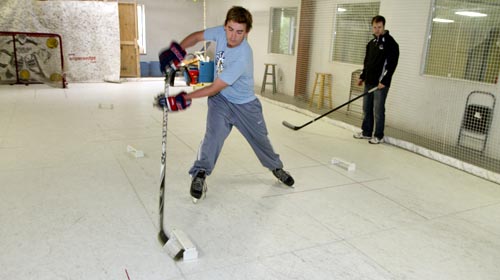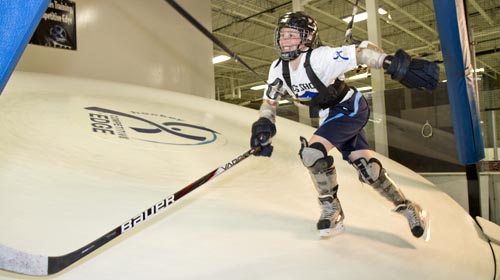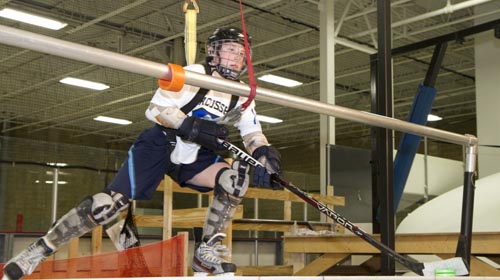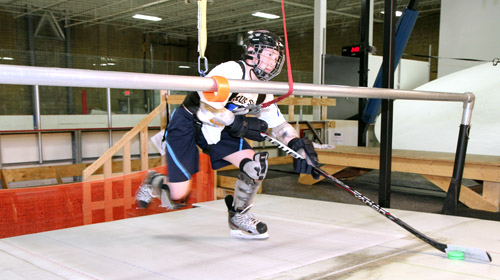Why does Competitive Edge have a skill and multitasking focus?
There is a lot of value to making a hockey player stronger and more athletic, no doubt, but we can do more than that.

There comes a point with and advanced player where most of the basic skill techniques are in place and at a high level. This player has reached a point where more repetition of basic level skills will result in a far slower rate of improvement as the motor control system has already made the adaptation to these skills. Competitive Edge takes pride in getting players to this stage.

At that point most hockey training tends to focus on building the athlete and developing team and game skill, and those, clearly, are great places to focus your hockey development efforts. With that said, more can be done on the skill side. We can take things to another level by pushing the player’s motor system to its limits by demanding complex challenges of many skill parts mashed together. We call this Multitasking Overload Training. It prepares the player for high-level mental pace of play, which is what separates the best of the best at the highest levels of the game.
“We will train your motor system into a high-capacity information super-highway to control your Hockey skill set at the pace needed for elite in-game performance.”
Why does high-capacity information flow facilitate top level pace of play? Lets use a robot and a computer “brain” as an analogy. If we were to design a robot to play hockey we would need to send information to the moving parts (legs, arms, etc.) and get information back regarding where those parts are, what they are feeling, and how good of a position they are in to do what we are planning to ask them to do next. Imagine trying to do this with a poor connection (like trying to watch Youtube on a smart phone from 5 years ago). Your robot would not be able to keep up with the pace of even a basic mite game.
Now imagine the same scenario with a superfast connection. Information flows between the moving parts and the “brain” almost instantly. This robot can now play the game at the pace of the game and, if the system is fast enough, even dictate change in the game as opposed to always reacting to changes dictated by opponents. Keep in mind that for this to be the case, part of this robot’s brain would have to be dedicated to thinking about reading and reacting to the game (the whole robot brain could not be focused on just controlling the robot’s body).
This is exactly what is demanded of our human “robots” (Hockey players) as they play the game. But we cannot engineer people to have “super fast” connections. Instead we have to train them. This article speaks to the way the brain responds to focused and purposeful practice and repetition (Note: If you don’t wish to read the article, keep in mind that the key points are summarized on this page.). It is not hockey specific, but all of its insight applies to hockey development.
Now, lets pull out the key points in the article. Through repetition, we build super-high-capacity information portals specifically set up for the skill set we wish to build. Scientists believe that we build this greater capacity by adding more neural connections. They also believe that we even more frequently do this by “reinforcing” our connections with Myelin (a fatty “insulation” that wraps our nerves and dramatically accelerates transmission along those nerves). Research has shown that repetitive practice that involves a particular nerve pathway stimulates the nervous system to add Myelin to the connections along that pathway over the following 48 to 72 hours.

Keep that image of Myelin reinforcing our nerve “wires” in your head and you are in some sense imagining skill development as it happens in the brain.
At Competitive Edge we want to maximize these pathways for the skills we need for Hockey. Players that can execute skills efficiently with good technique can start to put those skills together to take on “multitasking challenges”. We take this to the extreme with “Multitasking Overload Training” where we ask one or both of two things…
- Players to do multiple challenging things at once.
- Players to string together many challenging things one after another in a short time.

By demanding an uncomfortable amount of motor control challenge together, we overload each players’ current multitasking ability and demand an adaptation by our system to be able to manage more hockey skill at once. More than any other reason, this is why we do Multitasking Overload Training with players who are ready. Until a good base of basic skill is in place, players should just be working on taking basic skill quality to a high level before working on overloaded multitasking training.

And keep in mind that the game will put players in situations where their multitasking ability is overloaded. Those who have best trained for these will thrive, those who haven’t won’t.
In short, we use Multitasking Overload Training to slow the game down for our students. There are lots of ways to build the athlete and add strength, but Competitive Edge training offers great and unique opportunities to control the multitasking demand and build the super-high-capacity motor control connections beyond the level of the competition.
Note: Much has been made about multitasking being bad for productivity in the office because your brain can only really do one thing at a time. This is true if you add “with the attentional spotlight” to the end of the sentence. The truth is that we are always doing many things at a time, but all of them except one are done “automatically” or without attention. Right now you are breathing, pumping blood around your body, moving your eyes to continue down the page, interpreting what you are reading, and vastly more.
So, in order to get better at multitasking, we must get better at making essentially all of the sub-tasks we need to do automatic (or higher quality when under automatic control). And our Multitasking Overload Training is all about improving the level of complexity that we can execute with automatic control over the sub-skills or over the whole complex task so we can keep the attention focused on reading and reacting to the play.